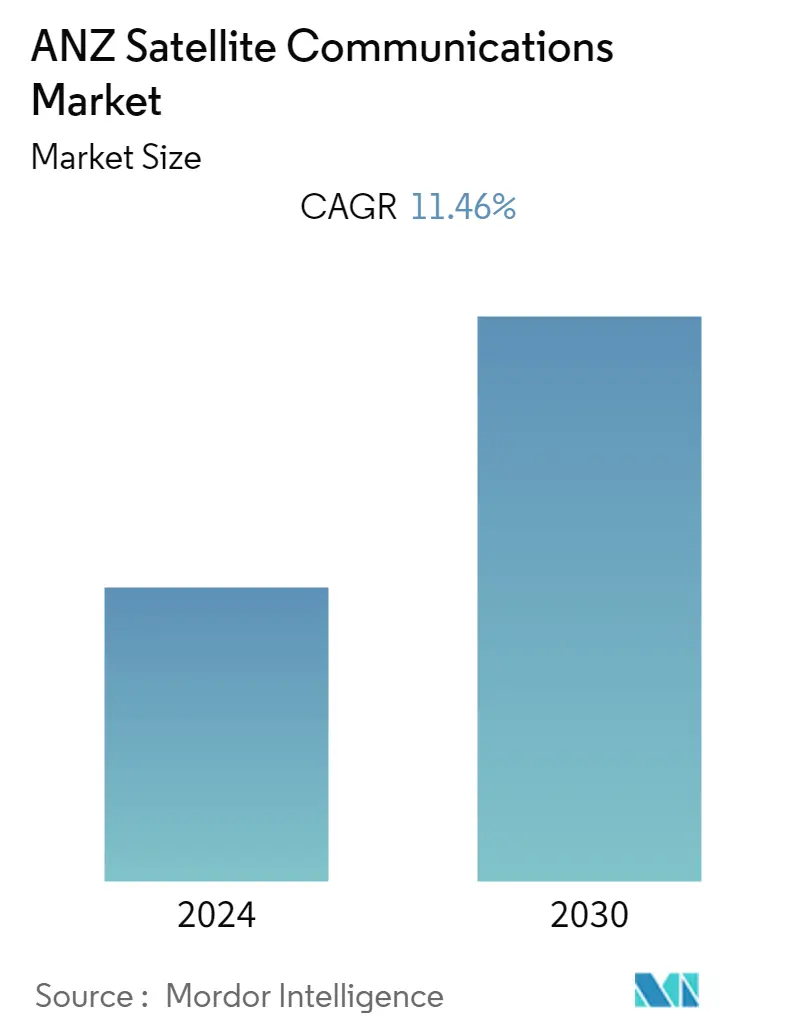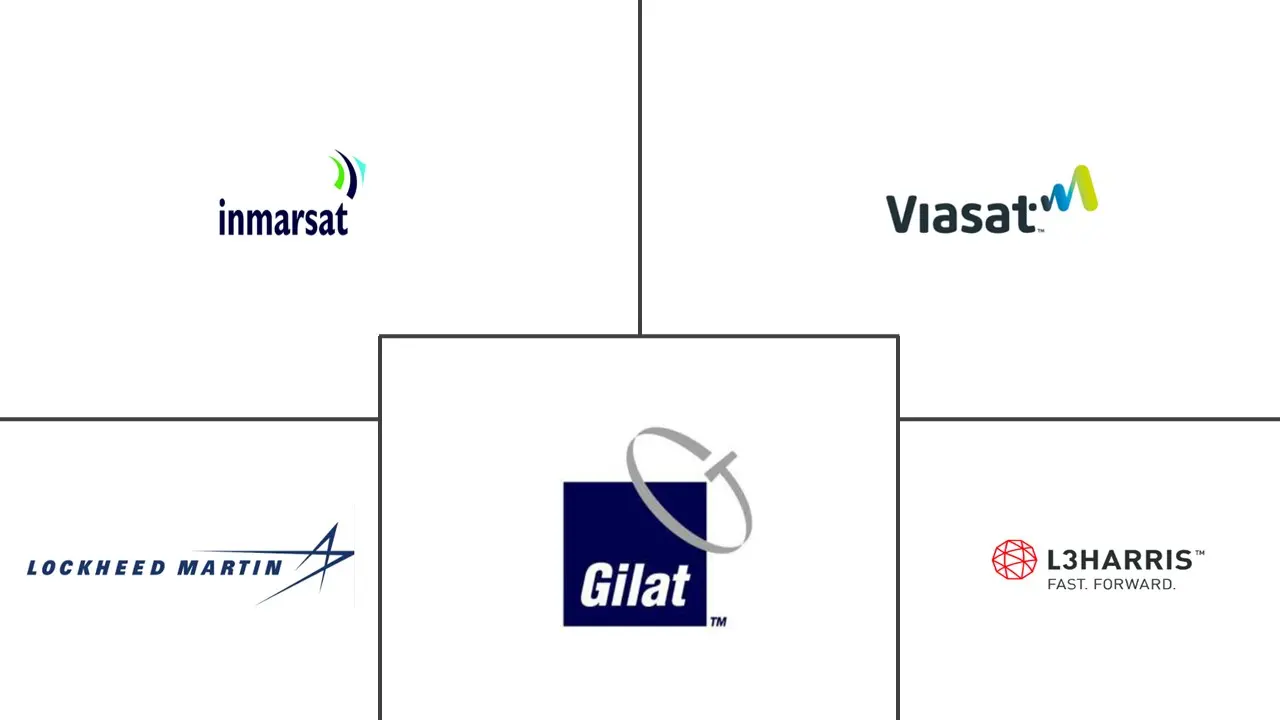Market Size of ANZ Satellite Communications Industry

| Study Period | 2019 - 2029 |
| Base Year For Estimation | 2023 |
| Forecast Data Period | 2024 - 2029 |
| Historical Data Period | 2019 - 2022 |
| CAGR | 11.46 % |
| Market Concentration | Low |
Major Players
*Disclaimer: Major Players sorted in no particular order |
ANZ Satellite Communications Market Analysis
The Australia and New Zealand satellite communications market is valued at USD 1.19 Billion in the current year. It is expected to grow at a CAGR of 11.46%% during the forecast period to USD 2.24 Billion by the next five years.
- Satellite communication has gained significant traction due to its excessive use in the defense and military sectors for transmitting information and establishing communication between military personnel. Furthermore, it also helps with satellite-asset tracking and remote sensing. For instance, life safety at sea has been gaining importance in the defense sector. The governments of various countries are investing in communication technology, such as navigation systems and vessel tracking. The governments of countries like China, the United States, the United Kingdom, and Indonesia play a vital role in promoting maritime security, as the maritime industry adds to the region's economic growth.
- As satellite technology developed, end users' direct access to capacity has become a severe problem. Instead of the traditional emphasis on network connectivity, ISOs and independent satellite systems are increasingly directing satellite technology toward providing services to end consumers. The conventional wisdom in satellite communication has been that the size of the receiving equipment and the power radiated from a satellite must be traded off. The most cost-effective systems for connecting a relatively small number of sites employed low-powered satellites sending signals to big stationary earth stations.
- The need for broadband connectivity is still tremendous and only sometimes location-specific. Examples of such requirements include connectivity for users on airplanes, ships, and vehicles (including first responders) operating in both stationary and moving locations. These three platforms require constant connectivity throughout their routes, frequently taking them through underserved portions of big cities and sparsely populated regions. Such improvements are anticipated to support the expansion of the market under study.
- Since launching a satellite to send data is so sensitive, cybersecurity has become a fundamental problem for satellite communication. The difficulty stems from the potential harm such cybersecurity risks could do because the flaws are crucial to the operation. Launch systems, communications, telemetry, tracking and command, and mission completion are mission-critical weaknesses vulnerable to cybersecurity threats. Its implementation needs to be improved by the excessive reliance on satellite communication for safe cyber capabilities during the satellite's lifetime.
- According to the Satellite Business Association, the commercial satellite business has been crucial in combating the COVID-19 pandemic. Due to its numerous uses in providing voice, data, and broadcast communications solutions, as well as navigation, earth observation, remote sensing, and other specialized services essential for businesses, government clients, and consumers domestically and globally, the demand for satellite communication has increased.
ANZ Satellite Communications Industry Segmentation
The ANZ satellite communication (SATCOM) market is defined based on the revenues generated from the types used in various end-user industries such as maritime, defense & government, enterprises, and media & entertainment, among other end-users. The analysis is based on the market insights captured through secondary research and the primaries. The market also covers the major factors impacting the market's growth in terms of drivers and restraints.
The scope of the study has been segmented based on the type of satellite communication equipment and services ( ground equipment (a gateway, very small aperture terminal (VSAT) equipment, network operation center (NOC), and satellite newsgathering (SNG) equipment) and Services (mobile satellite services (MSS), fixed satellite services, and earth observation services) and end-user vertical (maritime, defense & government, enterprises, media & entertainment, and other end-user verticals). Common satellite communication services include voice calling and internet access for different applications. The study tracks the key market parameters, underlying growth influencers, and major vendors operating in the industry, which supports the market estimations and growth rates over the forecast period. The study also tracks the revenue accrued through the sale of grown equipment and communication services that are being used in various end-user industries across geography. In addition, the study provides the SATCOM market trends, along with key vendor profiles. The study further analyses the overall impact of COVID-19 on the ecosystem.
ANZ Satellite Communications Market Size Summary
The Australia and New Zealand satellite communications market is experiencing robust growth, driven by increasing demand in defense, military, and commercial sectors. The market is characterized by significant investments in communication technologies, such as navigation systems and vessel tracking, to enhance maritime security and economic growth. The evolution of satellite technology has shifted focus from traditional network connectivity to providing direct services to end consumers, addressing the growing need for broadband connectivity across various platforms, including airplanes, ships, and vehicles. This shift is supported by partnerships and collaborations among key industry players, aiming to enhance satellite communication capabilities and address cybersecurity challenges.
The market landscape is highly fragmented, with major players like Inmarsat Global Limited, Lockheed Martin, Gilat Satellite Networks Ltd, Viasat Inc., and L3Harris Technologies Inc. actively engaging in strategies such as partnerships, innovations, and acquisitions to strengthen their market position. Notable developments include Lockheed Martin's selection for Australia's JP9102 project, which aims to establish a sovereign-controlled satellite communication system, and Inmarsat's contract for satellite positioning to improve navigation accuracy. These advancements, along with the integration of satellite communication in various sectors like aviation, maritime, and emergency services, underscore the critical role of satellite technology in enhancing connectivity and operational efficiency in Australia and New Zealand.
ANZ Satellite Communications Market Size - Table of Contents
-
1. MARKET INSIGHTS
-
1.1 Market Overview
-
1.2 Industry Attractiveness - Porter's Five Forces Analysis
-
1.2.1 Bargaining Power of Buyers
-
1.2.2 Bargaining Power of Suppliers
-
1.2.3 Threat of New Entrants
-
1.2.4 Threat of Substitutes
-
1.2.5 Intensity of Competitive Rivalry
-
-
1.3 Industry Value Chain Analysis
-
1.4 Assessment of the Impact of COVID-19 on the Market
-
-
2. MARKET SEGMENTATION
-
2.1 By Type
-
2.1.1 Ground Equipment
-
2.1.2 Services
-
-
2.2 By Platform
-
2.2.1 Portable
-
2.2.2 Land
-
2.2.3 Maritime
-
2.2.4 Airborne
-
-
2.3 By End-user Vertical
-
2.3.1 Maritime
-
2.3.2 Defense and Government
-
2.3.3 Enterprises
-
2.3.4 Media and Entertainment
-
2.3.5 Other End-user Verticals
-
-
ANZ Satellite Communications Market Size FAQs
What is the current ANZ Satellite Communications Market size?
The ANZ Satellite Communications Market is projected to register a CAGR of 11.46% during the forecast period (2024-2029)
Who are the key players in ANZ Satellite Communications Market?
Inmarsat Global Limited, Lockheed Martin, Gilat Satellite Networks Ltd , Viasat Inc. and L3Harris Technologies Inc are the major companies operating in the ANZ Satellite Communications Market.

